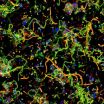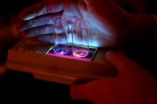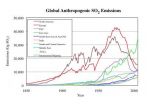(Press-News.org) MBL, WOODS HOLE, MA—Like people in cities, microbes often live in complex communities that contain many different microbial types. Also like us, microbes tend to gravitate to and "hang out" with certain other types in their community, more than with the rest. And sometimes, when opportunities arise, they move to more favorable locations.
But until recently, scientists have not been able to look at a microbial community and distinguish the spatial relationship of more than 2 or 3 kinds of microbes at once.
Now, a microscopy technique developed at the Marine Biological Laboratory (MBL), allows scientists to see the spatial arrangement of up to 28 differently labeled microbes in a single field of view.
"We get information on the presence of many different microbes at once and get it quickly, cheaply, and perhaps more accurately than other methods," says Gary Borisy, president and director of the MBL and co-author of a paper describing the technique published today in Proceedings of the National Academy of Sciences.
"Just as you may move to a certain neighborhood because the schools are good for your kids, the neighborhood is important for microbes," Borisy says. "When we find out where (in a community) they like to hang out, that has implications for how they function."
The new technique, called CLASI-FISH (combinatorial labeling and spectral imaging fluorescent in situ hybridization), is faster than traditional ways of identifying the microbes in a sample (by laboratory culture or by DNA sequencing). Plus, it reveals the spatial structure of the community, which these methods do not.
"We don't just find out who is there. We find out where they are in space," Borisy says.
Borisy and his colleagues, including Floyd Dewhirst of the Harvard School of Dental Medicine, used the technique to analyze dental plaque, a complex biofilm that is known to contain at least 600 species of microbes. They were able to visually discriminate 15 different microbial types, and to determine which 2 types (Prevotella and Actinomyces) showed the most interspecies associations.
"That might imply some functional interaction between them," Borisy says. "One may be facilitating the other to colonize the site, and the exchange will reap some benefit for them both."
The lead author on the paper is Alex M. Valm, a student in the Brown-MBL Graduate Program in Biological and Environmental Sciences. Another team member, MBL scientist Jessica Mark Welch, is leading the effort to apply CLASI-FISH to the organization of microbial communities in another setting—the guts of mice harboring defined populations of human microbes.
"It's very possible that this technology will enable a new kind of clinical diagnostic procedure, so that it will be possible to very quickly and accurately diagnose a specimen for many kinds of microbes at once," Borisy says. "As an alternative to culturing, it could be faster, cheaper, and better."
INFORMATION:
Resources:
Citation:
Valm, A.M., Mark Welch, J.L., Rieken, C.W., Hasegawa, Y., Sogin, M.L., Oldenbourg, R., Dewhirst, F.E., and Borisy, G.G. (2011) Systems-level analysis of microbial community organization through combinatorial labeling and spectral imaging. PNAS Early Edition (Feb. 14), doi/10.1073/pnas.1101134108.
The Marine Biological Laboratory (MBL) is dedicated to scientific discovery and improving the human condition through research and education in biology, biomedicine, and environmental science. Founded in 1888 in Woods Hole, Massachusetts, the MBL is an independent, nonprofit corporation.
Choosing your neighbors: MBL scientists see how microbes relate in space
2011-02-15
ELSE PRESS RELEASES FROM THIS DATE:
Jewel-toned organic phosphorescent crystals: A new class of light-emitting material
2011-02-15
ANN ARBOR, Mich.---Pure organic compounds that glow in jewel tones could potentially lead to cheaper, more efficient and flexible display screens, among other applications.
University of Michigan researcher Jinsang Kim and his colleagues have developed a new class of material that shines with phosphorescence---a property that has previously been seen only in non-organic compounds or organometallics.
Kim and his colleagues made metal-free organic crystals that are white in visible light and radiate blue, green, yellow and orange when triggered by ultraviolet light. ...
Treating the aging knee as an organ
2011-02-15
DETROIT – The human body is made up of several organs composed of tissues that enable them to perform a particular function. The heart circulates blood; the brain is the micro-neuro center of the body; the lungs bring in oxygen and release carbon dioxide.
The failure of any one of these tissue systems can cause serious health issues, even death. When components of the organ are fixed, typically the organ functions better. For instance, unclogging a blocked artery with a balloon stent improves blood circulation to and from the heart.
Henry Ford Hospital researcher Fred ...
Does social anxiety disorder respond to psychotherapy? Brain study says yes
2011-02-15
When psychotherapy is helping someone get better, what does that change look like in the brain? This was the question a team of Canadian psychological scientists set out to investigate in patients suffering from social anxiety disorder. Their findings are published in Psychological Science, a journal of the Association of Psychological Science.
Social anxiety is a common disorder, marked by overwhelming fears of interacting with others and expectations of being harshly judged. Medication and psychotherapy both help people with the disorder. But research on the neurological ...
UCLA Engineering advance with new nanomaterials good news for next-generation electronic devices
2011-02-15
In recent years, topological insulators have become one of the hottest topics in physics. These new materials act as both insulators and conductors, with their interior preventing the flow of electrical currents while their edges or surfaces allow the movement of a charge.
Perhaps most importantly, the surfaces of topological insulators enable the transport of spin-polarized electrons while preventing the "scattering" typically associated with power consumption, in which electrons deviate from their trajectory, resulting in dissipation.
Because of such characteristics, ...
Physicists isolate bound states in graphene-superconductor junctions
2011-02-15
CHAMPAIGN, Ill. — Illinois researchers have documented the first observations of some unusual physics when two prominent electric materials are connected: superconductors and graphene.
Led by University of Illinois physics professor Nadya Mason, the group published its findings in the journal Nature Physics.
When a current is applied to a normal conductor, such as metal or graphene, it flows through the material as a stream of single electrons. By contrast, electrons travel in pairs in superconductors. Yet when a normal material is sandwiched between superconductors, ...
Psychology students to present on cheaper textbook alternatives at national conference
2011-02-15
A group of University of Cincinnati seniors in the psychology program will nationally present their comparison of educational technology alternatives to purchasing college textbooks that can run into hundreds of dollars per academic quarter. Their research as part of the statewide Ohio Digital Bookshelf Project will be presented on Monday, Feb. 14, at the national EDUCAUSE Annual Meeting in Washington, DC.
The Digital Bookshelf Project is an initiative under the University System of Ohio (USO) Strategic Plan for Higher Education to develop a high-quality, affordable, ...
Gene that regulates immune system linked to preeclampsia
2011-02-15
Researchers at North Carolina State University have discovered that the placentas of women who suffer preeclampsia during pregnancy have an overabundance of a gene associated with the regulation of the body's immune system. Their discovery may lead to improved screening and prenatal care for these patients and their babies.
Preeclampsia occurs in up to 10 percent of all pregnancies, and is responsible for about 15 percent of pre-term births. The disorder is usually marked by a rapid rise in blood pressure that can lead to stroke, seizures or organ failures in the mother. ...
Study shows year-end test scores significantly improved in schools using Web-based tutor
2011-02-15
WORCESTER, Mass. – Year-end test scores of Massachusetts middle school students whose teachers used a Web-based tutoring platform called ASSISTments as a central part of their mathematics instruction were significantly better than those of students whose teachers did not use the platform, according to a recent study published in the Journal of Educational Computing Research. Conducted by Neil T. Heffernan, PhD, of Worcester Polytechnic Institute (WPI), and Kenneth R. Koedinger, PhD, and Elizabeth A. McLaughlin, both of Carnegie Mellon University, the study examined data ...
Worldwide sulfur emissions rose between 2000-2005, after decade of decline
2011-02-15
COLLEGE PARK, Md. -- A new analysis of sulfur emissions appearing in the journal Atmospheric Chemistry and Physics shows that after declining for a decade, worldwide emissions rose again in 2000 due largely to international shipping and a growing Chinese economy. An accurate read on sulfur emissions will help researchers predict future changes in climate and determine present day effects on the atmosphere, health and the environment.
"Sulfur dioxide is an important component of the atmosphere. It changes the radiative balance of the earth by influencing the amount of ...
Early signs of heart disease in preadolescent children with type 1 diabetes
2011-02-15
Cardiovascular disease is the leading cause of death in patients with diabetes. Patients with type 1diabetes have a 200 percent to 400 percent greater chance of developing cardiovascular disease than those without diabetes. Medical College of Wisconsin researchers at Children's Hospital of Wisconsin discovered the early signs of cardiovascular disease are likely to manifest before the onset of puberty in many children with diabetes.
Those findings are published in the February 2, 2011 online version of Diabetes Care and will be in the March 2011 issue of Diabetes Care.
Led ...



